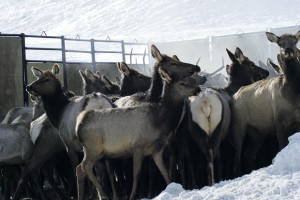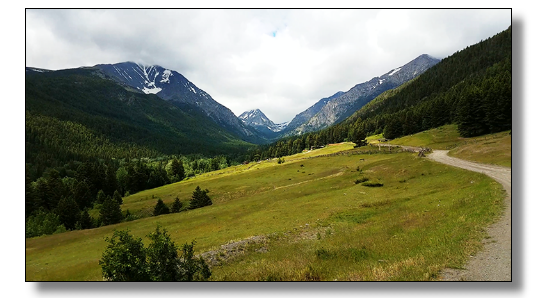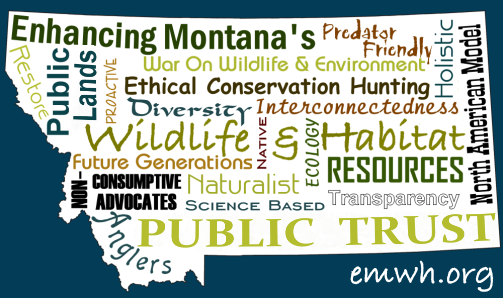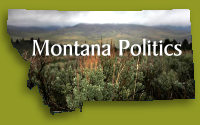Governor Bullock's Brucellosis
Elimination Reply Email
Is Bullock sanctioning
test and slaughter of Montana's
elk, bison, moose and deer?

At the Interagency Bison Management Program on November 21, 2013, MT DOL's State Veterinarian stated, during the Brucellosis Seroprevalence discussion, that they would be conducting a capture, test, slaughter and vaccination program with the wild bison exiting Yellowstone National Park, beginning this February. Familiar with the academic papers on the unrealistic and uneconomical subject, as well as the 0.0-0.3% risk that wild bison could possibly transmit the livestock disease brucellosis, back to domestic cattle (no documented case of wild bison to domestic cattle transmission has ever occurred in the wild), I emailed Governor Bullock, to share the science with him, in hopes that he would stop the DOL's 2014 slaughtering of thousands of bison as they exited the Park, as they did in the winter of 2005/2006 and again in 2008. The reply I received, which turned out to be canned, was such a factual, politicized disappointment involving elk and bison, I had to write a rebuttal to correct all the literal bullshit. Below is my reply, with Governor Bullocks email following. I have also included my original bison vaccination citations email below his. So if you like to read in chronological order, start at the bottom. I have received no reply from the Governor's office from this Dec. 26th rebuttal email. Additional notes, I have repeatedly requested Montana's official position on brucellosis in wildlife, including the Governor's office, and received no such policy statement. I have also researched and uncovered documents that show the State has signed onto USDA APHIS's Brucellosis Management Plan (posted soon) with APHIS, whose current mission statement is the eradication of brucellosis in wildlife - the elk and bison (as well as other cervids) of the the GYA. Montanan's public and our public trust wildlife deserve better! |
Please contact Governor Steve Bullock and voice your concern that test and slaughter/vaccine programs are not efficient, economical, nor socially acceptable management tools for our treasured and public trust wildlife.
Governor Steve Bullock
406-444-3111
Toll Free: 855-318-1330
FAX: 406-444-5529
Email: governor@mt.gov
Mail: Office of the Governor
PO Box 200801
Helena MT 59620-0801
Subject: Re: Thanks for your
email Governor Bullock, I don't know if you actually wrote this reply email (below my reply) or if you authorized others to send canned replies, but your name is signed on this email, therefore, I am going to address it as being authored by you. Your reply email is loaded with scientific and factual inaccuracies, and thus writing makes you look ignorant of a very controversial issue here in Montana, not becoming to a person in your position, with the resources at your disposal. As the governor, I hold you to a higher caliber on these matters. If you did not actually read my email, sent on November 24, 2013, with the current science, or that of others that I know have written to you, and if your advisers are not getting the responsible scientific data to you, then I suggest firing them and hiring some responsible science advisers onto your staff so you dont lose more credibility on this issue. My email of Nov. 24 was not a complaint based on emotionalism (I've attached my email, just in case you didn't actually read it the first time), I addressed the science of bison vaccination and brucellosis risk transmission, of which your state DOL veterinarian, Dr. Marty Zaluski, was involved with and cited himself, when he was defending Montana livestock to the Texas Animal Health Commission in September. Y'all cant play this both ways - using real science to defend MT cattle to Texas or any other state, while simultaneously fabricating MT livestock propaganda here in Montana to gain control over FWP, sportsmens dollars and our "treasured wildlife" - a public trust. You are being found out and will be held accountable before the people of Montana by researchers like myself. Below is a list of the factual inaccuracies
obvious in your email. "The Montana Department
of Livestock, the State Veterinarian and the Interagency Bison
Management Plan have informed the process of bison vaccination
in Montana, which has been in place since 2000." "Frustrated by the agencies' handling of the issue and believing their interests were not being addressed, a group of ranchers, conservationists, and hunters in Jackson Hole, Wyoming, wrote a letter to the Clinton administration in January 1997, in the midst of the crisis. They requested that APHIS stop threatening to downgrade the state's brucellosis-free status. Ranchers in Jackson Hole, they noted, had been running cattle next to bison for more than thirty years with no outbreaks of brucellosis." - Finding Common Ground, pg. 138, letter being foia'd. - More importantly, no documented case of
bison to cattle transmission in the wild has ever occurred, so
the whole IBMP is a taxpayer funded political sham not based on
science, which they have known about for years. In September, MTDOL's Dr. Marty Zaluski publicly
testified in Texas, "Montana's DSA includes 282 operations
with 73,200 cattle and domestic bison. This fiscal year, 42,025
of the 73,200 animals have been tested to achieve a 99% confidence
that the disease (if it exists) is present at a rate of less that
0.008%. The chance that any one Montana animal is brucellosis
positive is 0.00024%." "So really the DSA in the state
of Montana is in southwest Montana. And it is designed to identify
the cattle at risk from brucellosis positive elk. So we know that
brucellosis positive elk are in southwest Montana, they can potentially
expose cattle and so the key to identifying the cattle at risk
is to identify where the brucellosis positive elk are."
- no mention of bison, because bison don't transmit to cattle. "As you may know, brucellosis
can cause animals to prematurely abort their young, so eliminating
the disease is important." Brucella abortus can cause abortions of firstborns. Wildlife have been adapting to this livestock introduced disease and their populations continue to grow despite the possibility of some abortion events of firstborns. What is important, for the peace of mind of the livestock community, is for taxpayer dollars to fund a better cattle vaccine (currently about 65% effective), rather than the fruitless waste of dollars trying to eliminate it from the wildlife, which is impossible without "sterilizing" (eradicating) all wildlife that can contract this bacteria, which here in the GYA includes cervids (elk, deer, moose), and wild bovines (bison). An Ecological Perspective
on Brucella abortus in the Western United States, 2013. Taxonomy
of Brucella, 2010. If you are advocating the appalling test and
slaughter of so many of our treasured wildlife for a small transmission
risk (0.00024%) from elk that can be mitigated, you would also
be committing to a massive long term economic hemorrhage for taxpayers,
for what? So is this the Montana policy on brucellosis in wildlife
that I have been calling and emailing your office and FWP concerning,
and have yet to received a response stating what Montana's position
is? Eradication of our elk, deer, moose and bison? Brucella abortus brucellosis routinely crops up in Texas (last one 2011) and has occurred in other states that have no genetic relationship to the GYA elk or bison. Yes, the GYA is a major reservoir in the US, partly because major amounts of wildlife were eradicated in other parts of the US. Is this what you are proposing, eradication of all wildlife, to achieve total eradication of Brucella abortus in wildlife? The livestock conditions which created brucellosis in the first place, still exist and in light of their over-antibiotic use, drug resistant superbug creation, you will probably be seeing a worse situation shortly (CDC, USDA, USAHA, NIAA and other industry websites and publications). Also, cases of brucellosis can occur from the cattle vaccines blooming (as in the MT domesticated bison in Madison County 2011, the Texas case in 2011 and an Idaho case in 2010 - the other Montana case confirmations from 2008 and 2010 awaiting HOOF-Print tests), which again, has nothing to do with the GYA elk or bison. Since the elk and the cattle biovar 1 (includes RB 51 and Strain 19 cattle vaccinations) are almost identical, you need to get into the HOOF-Prints tests to see whether it is an elk strain, cattle strain or cattle vaccine strain. "Our results indicate that elk and
cattle isolates are virtually identical genetically, differing
by only one to two mutational steps. On the contrary, bison B.
abortus differed from cattle and elk by 12-20 mutational steps."-
DNA Genotyping Suggests that Recent Brucellosis
Outbreaks in the Greater Yellowstone Area Originated from Elk,
2009. Molecular Epidemiology of Brucella abortus Isolates from
Cattle, Elk, and Bison in the United States, 1998 to 2011, 2012. "In fact, about fifty
percent of bison have brucellosis, and even more troubling, about
70 percent of calving-age female bison do." Brucellosis is the disease, which cannot be diagnosed unless the animal is killed and a culture grown from their lymph glands or abortion/birthing materials. Seropositive, on the other hand, simply means that in a blood test, they show the antibody markers for having at one time come in contact with the disease, not that they are currently infected, nor infectious. Seropositive can also represent immunity. The seroprevalence of bison is immaterial, since they have not spread it to the elk, nor cattle. Genetic Natural Resistance to Brucellosis in Yellowstone National Park Bison (Bison Bison), 2013. Diagnosis of Brucellosis in Livestock and Wildlife, 2010. "Only about 15-20 percent
of elk have brucellosis in Montana." Regardless of the lower elk seroprevalence (again, not all cases are brucellosis infection/infectious), it is the elk biovar that are nearly identical to that of domesticated cattle and is responsible for the transmission from wildlife to domesticated cattle. Also, according to the science, of which DOL's Dr. Marty Zaluski has been a contributor to and a testifier to, the risk that any one Montana cattle could become infected with brucellosis from elk is 0.00024%. Bison are not even a factor here and a 0.00024% elk transmission chance is not worth the slaughter of mass amounts of "our treasured wildlife". In addition, "...vaccination of elk with Brucella Strain 19 has been conducted on feedgrounds in Wyoming since 1985 with no effect on seroprevalence and limited effect on abortion." - An Ecological Perspective on Brucella abortus in the Western Untied States, 2013. DNA Genotyping Suggests that Recent Brucellosis Outbreaks in the Greater Yellowstone Area Originated from Elk, 2009. https://www.emwh.org/issues/brucellosis/livestock%20tahc.htm A Risk Analysis of Brucella abortus Transmission Among Bison, Elk and Cattle in the Greater Yellowstone Area, 2010. An Ecological Perspective on Brucella abortus in the Western Untied States, 2013. "A collective effort—like
what is currently being done—has the potential to significantly
reduce brucellosis, helping preserve our treasured wildlife and
livestock." In addition, the IBMP has been operating in
this non-"collective" fashion since 2000. After the
last major bison slaughter created such a public outcry, resulting
in a Congressional Oversight Hearing on the matter, the GAO report
stated of the IBMP agencies, "That’s exactly
why bison vaccination is part of the management plan." So of your letter, only your opening statement. "Bison are a treasured wildlife species and play an important role in Montana’s history and the cultures of the people who have called this land home for 400 generations." is accurate. We have a phrase for that, back in Texas. To be a wee bit more politically correct and put a bow on it - Male Bovine Blossoms! I expect better from your office - "on behalf of all Montanans." MCA 2-3-201. Legislative intent -- liberal construction. The legislature finds and declares that public boards, commissions, councils, and other public agencies in this state exist to aid in the conduct of the peoples' business. It is the intent of this part that actions and deliberations of all public agencies shall be conducted openly. The people of the state do not wish to abdicate their sovereignty to the agencies which serve them. Thank you, On 12/18/2013 11:28 AM, Governor Bullock wrote:
|
Subject: Dol bison slaughter and vaccination
plan Governor Bullock, Tim Baker, Board of Livestock, I am writing to protest the the plans of the DoL to begin a test, slaughter and vaccination campaign on the YNP bison that exit the Park this winter, or in the future. I was at the IBMP meeting on Nov. 21st and heard the numerous and repeated objections of the other IBMP partners. I also am a constant researcher of the issues and science involving brucellosis, the livestock and our wildlife. From a technical report that Dr. Marty Zaluski was a contributing author, it states, "The estimated percentage of cattle exposure risk from the Yellowstone bison herd is small (0.0 - 0.3% of total risk)." The .3% is added simply "in case". There has not been a documented case of bison to cattle transmission. Zaluski also stated at the Texas Animal Health Commission hearing, "This fiscal year, 42,025 of the 73,200 animals have been tested to achieve a 99% confidence that the disease (if it exists) is present at a rate of less that 0.008%. The chance that any one Montana animal is brucellosis positive is 0.00024%." That is from the 99.7-100% risk of transmission from the elk. This elk risk of transmission is a very rare occurrence, one that other Montana cattle organizations and ranchers also openly stated to Texas. Certainly not warranting the obscene eradication measures that keep targeting the wildlife. More cattle die in vehicular accidents each year in Montana than in many years ever contract brucellosis. Is that going to begin a crusade to eradicate vehicles? That would be just as absurd as the current campaign against the bison and elk. On top of these statistics are the facts of
the bison vaccine. 1. Bison vaccine is disputed,
2. Does not prevent brucellosis infection, only
marginally protects from abortion, and is not longterm, 3.
Single shot vaccine showed no difference with non-vaccinated,
4. Commitment to booster vaccinations and long
term programs (30 years) would be necessary and would be at great
cost and manpower hours with limited results, 5.
Vaccinated bison would still contract field strains of Brucella
abortus, requiring slaughter and loss to program, 6.
Vaccination during mid-gestation induces greater abortions, 7.
Bison vaccination, in an attempt to lower seroprevalence, will
have no effect on reducing seroprevalence in the elk population
currently the primary transmission risk vector to the cattle,
8. Efficacy of RB51 vaccine has not been tested
in field conditions, 9. Test and slaughter/vaccine
programs are not efficient or socially acceptable management tools
for wildlife. The negative publicity the 2005-2006 slaughters reflected so poorly on Montana that a Congressional Oversight Hearing was held. The internet and its networks are far more sophisticated than they used to be, this will not be kept quiet. In addition, I have been researching the economics of the eradication campaign, the funding that is legislatively sponsored from Montana and the other two GYA states, funneled through APHIS back to the state, through a defunct organization, all for the purpose of eradicating brucellosis in wildlife with taxpayers dollars for something that will have minimal effect for an outrageous expense, due to politics, not sound science. More of the Montana, as well as the US public and organizations will become armed with this data, to defend the wildlife. It would be far more prudent for those monies and energies to be applied in a constructive manner to benefit the livestock industry, such as a more effective cattle vaccine for cattle, rather than a nefarious campaign against wildlife. Raul M. Grijalva (Chairman of the Subcommittee in the Oversight Hearing) stated, "Any legitimate threat of disease must be managed effectively but of equal importance - the slaughter of bison needs to stop... Effective disease control and free-roaming bison are not mutually exclusive. Given the enormous scientific and financial resources of the Departments of Interior and Agriculture, along with the resources and expertise of Montana, Wyoming and Idaho, I am confident that bison and cattle can be managed in a way that is not a death sentence for either species." His words would serve us well. I would ask that you abandon the lethal political campaign against our wildlife. Thank you, |
Please contact Governor Steve Bullock and voice your concern that test and slaughter/vaccine programs are not efficient, economical, nor socially acceptable management tools for our treasured and public trust wildlife.
Governor Steve Bullock
406-444-3111
Toll Free: 855-318-1330
FAX: 406-444-5529
Email: governor@mt.gov
Mail: Office of the Governor
PO Box 200801
Helena MT 59620-0801
Site designed and maintained by Kathryn QannaYahu




